Video
The Stirone and Piacenziano Regional Park unfolds for visitors. A natural district that, starting from Fidenza, extends towards the Apennine hinterland for almost 15 km, incorporating nine areas of great paleontological interest located between Castell'Arquato, Lugagnano Val d’Arda, Vernasca, Gropparello and Carpaneto Piacentino.
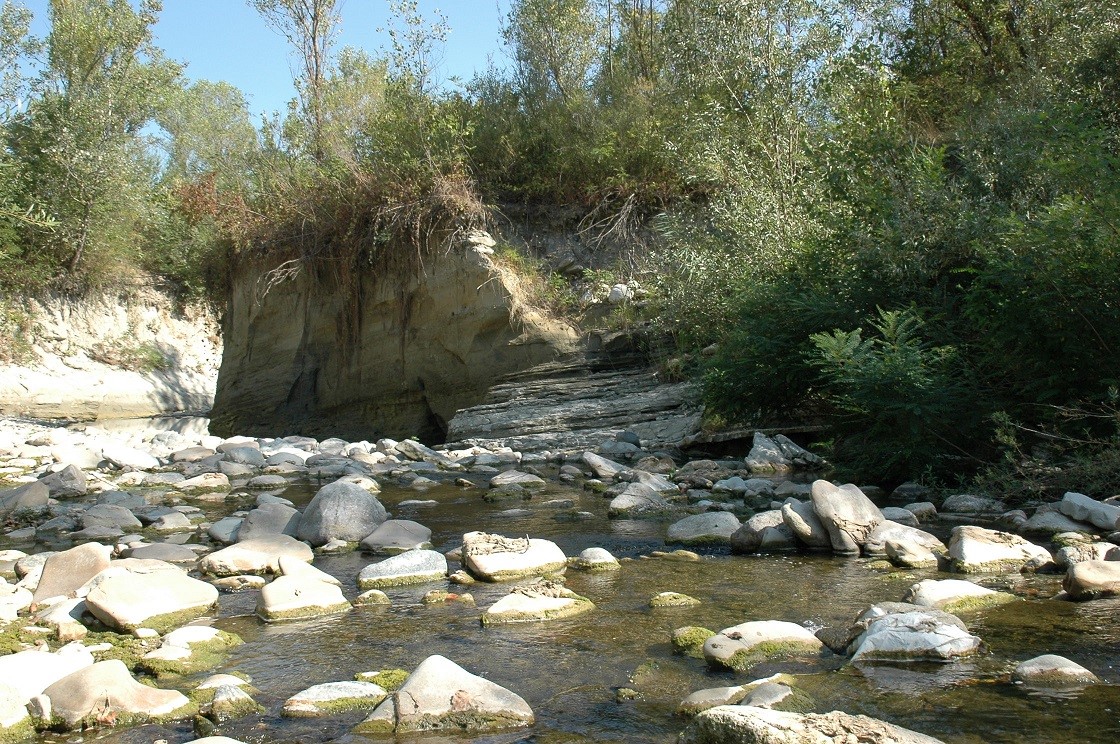
It is a protected area of indescribable charm that offers not only pleasant landscape views, but also important data for the reconstruction of the history of the region. The erosive processes on the banks of the river have revealed fossil deposits of great value from the Tertiary and Quaternary periods, making this district well-known to the international scientific world.
The hall of honor of the museum houses the complete collection of species characteristic of the Piacenziano stratotype visited by scholars who come to Castell’Arquato to carry out research from all over the world. Most of the fossils found in the outcrops in which the stratotype is present belong to the Molluscs and more precisely to the two classes of Gastropods and Bivalves and, with few species, to the class of Scaphoopods.
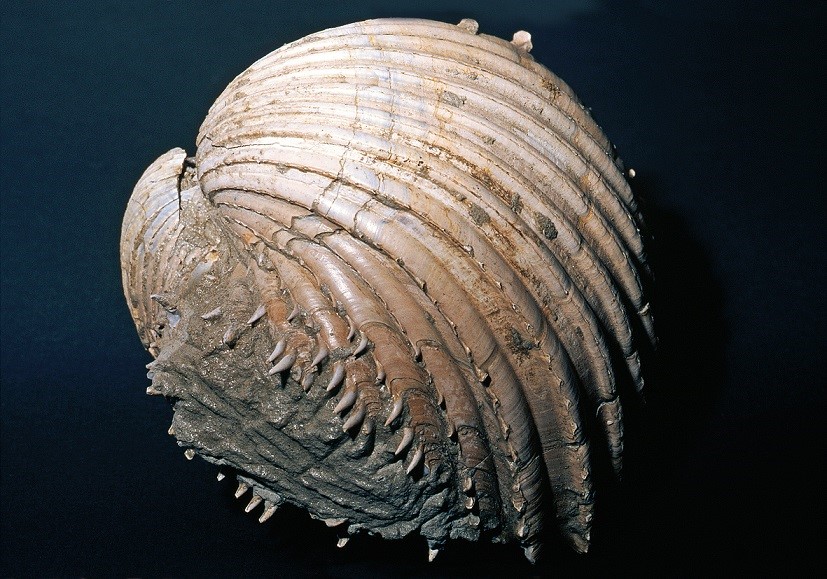
The importance and the great variety of fossils in Castell'Arquato, especially with regard to malacology, repeatedly attracted the attention of numerous scholars including Brocchi who in his "Subappennine fossil conchology" in 1814 presents his own collection ( one of the best known collections of the European Tertiary), now preserved in the Natural History Museum of Milan, where there are several finds from Castell'Arquato.
Since the late eighteenth century, the fossil record of the “Pliocene Sea” was brought to light in the clay and sandy soils of the eastern Apennines of Piacenza, and in particular along the steep walls of the calanchi and in incisions made by small streams in the valleys of the Nure, Chiavenna, Arda and Ongina. But already three centuries before this, Leonardo da Vinci, who first recognized the organic origin of fossils, saw the shells collected in the Piacenza area while he was in Milan, working on the equestrian statue of Francesco Sforza. His reference to these fossils, which he called nicchi, is shown in the celebrated Leicester Codex:

"In the mountains of Parma and Piacenza a great multitude of worm-eaten shells and corals can be seen, still joined to the stones, which I had the opportunity to see when I was living in Milan and working on the great horse. A large bag of them, some in an excellent state of preservation, was brought to my studio by some peasants”
Aristotele (384-322 b.C.) influenced the ancient thought about the origin of the fossils. He thought they derived from a "formative vis" produced during the deluge of Deucalione and Pirra.
At the origin of the fossils Avicenna (980-1037) thought a "plastic vis" would have been able to shape bodies, but not to infuse life. The same Avicenna resumed the Aristotelian conception that there was the Universal deluge at the origin of the imprints of aquatic animals. This thesis followed by the official science until Leonardo’s age.
The first to understand the true importance to these remains were some landowners of the Val d'Arda. They began to gather large numbers of fragments of shells and bones in the vicinity of the villages of Lugagnano and Castell’Arquato and so created the first collections.
But the scholar who contributed most to the research and knowledge of the local Pliocene was Giuseppe Cortesi, adviser to the court of Piacenza and later honorary professor of Geology at the University of Parma. He became so engrossed by the search that he hired observers to supervise the region and alert him if skeletal fragments emerged. He soon succeeded in amassing a collection not only of shells but also the remains of rhinoceroses, elephants and above all dolphins and whales.
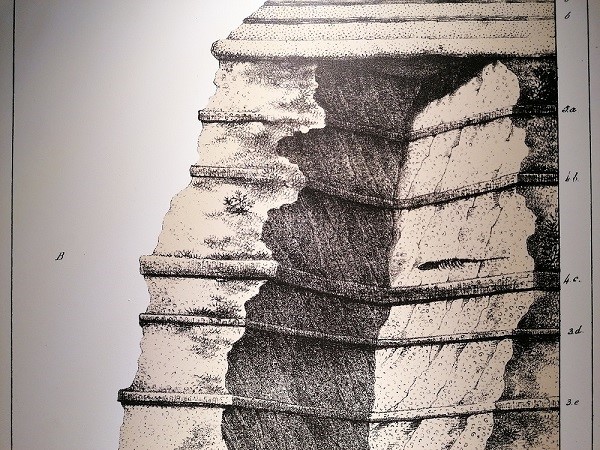
The numerous fossil skeletons collected by Cortesi before 1809 were purchased by the Lombardo-Venetian Kingdom and later moved to the Natural History Museum of Milan but lost during World War II. The material gathered by the naturalist after 1809 was purchased by the government of Parma in 1841 for the Cabinet of Natural History at the University, which later also acquired the fossil skeletons of other cetaceans found on the Piacenza hills from another local researcher, Giovanni Podestà of Castell’Arquato.
The importance and great variety of fossil specimens, especially with regard to malacology, on various occasions aroused the interest of scholars, including Giovanni Battista Brocchi. In his “Conchiologia fossile subapennina” (1814) he published his collection (one of the most famous of the European Tertiary period), which is now in the Natural History Museum of Milan and contains numerous items from Castell’Arquato.
Georges Cuvier was also interested in the fossils found in Val Chiavenna and Valdarda, personally visiting Cortesi’s collection and mentioning it in his works.
The interest in the discoveries made in the Piacenza area during this period was heightened by the fact that most of the local collections were sold abroad and this helped disseminate the fossils of the Val d'Arda to the major European museums and stirred the interest in this location among scholars from various countries.
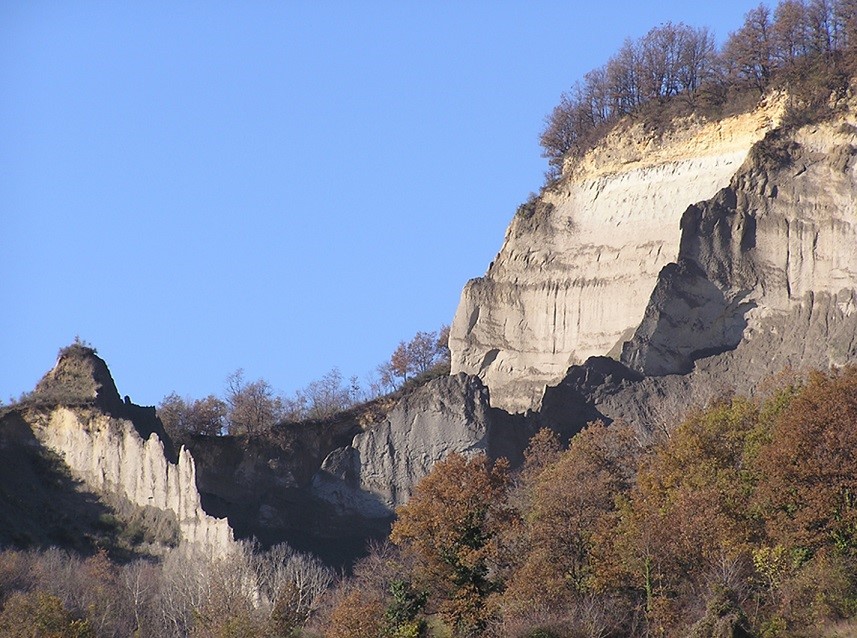
In 1858 the Swiss scientist Carl Mayer developed a geological plan which takes its name from the province of Piacenza: the Piacenzian (Piacenzische Stufe) used to indicate the “blue clay” (Blue Mergel), of which the Val d'Arda is the most typical zone. Subsequently, in 1865, Lorenzo Pareto suggested taking as the “type section” of the Piacenzian the succession of strata outcropping on the left bank of the Arda Torrent between the towns of Lugagnano and Castell’Arquato.
Recently the scientific community has returned to the concept of the Piacenzian to redefine its time limits (the term is used to indicate land of marine origin between 3.5 and 2.5 million years old) and above all proposing to reuse as the basis of comparison that part of the stratotype that lies between Monte Giogo and Castell’Arquato, where the faunal associations clearly document the “extinctions” caused by the climatic deterioration that accompanied the formation of the Arctic ice caps.
The extraordinary abundance of fossil remains in these sediments and their excellent state of preservation provide a particularly significant basis of study for those who are interested in issues bound up with the evolution of the population of the Mediterranean basin and above all the faunal changes that accompanied its environmental development.

Stephanorhinus hundsheimensis (Toula, 1902)
This medium-large rhinoceros stood over 200 cm tall at the shoulder and had two horns on its snout. It appeared in the late Pleistocene and spread to Central and Southern Europe, including Italy. It was a generalist rhinoceros, capable of adapting to both wooded and steppe environments, with a slight preference for the former.
It died out around 500,000 years ago due to competition from two other species of rhinos that arrived from Asia and were more specialized: Stephanorhinus kirkbergensis, or Merk’s rhinoceros, adapted to forested environments, and Stephanorhinus hemitoechus, or the steppe rhinoceros, adapted to open environments.
Coelodonta antiquitatis (Blumenbach, 1799)
During cold phases, the woolly rhinoceros was present in the Po Valley. It was covered with fur with a very thick undercoat and two horns, one of which was very long and flattened at the sides.
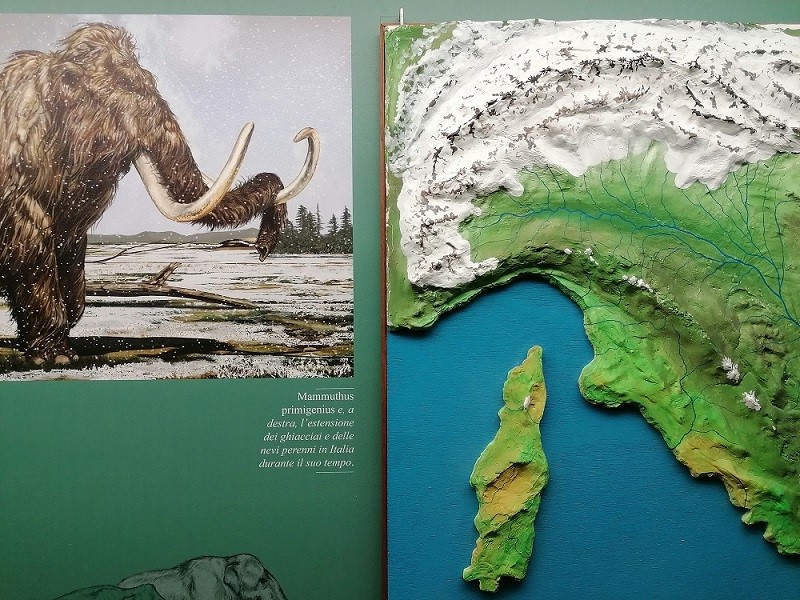
In common parlance, the informal term “ice age” refers to the Quaternary Period or Pleistogene (Pleistocene + Holocene), when continuous climatic cooling began 2.51 million years ago and culminated in a series of glaciations (or ice ages) interspersed with warmer interglacial phases (or interglaciations). Though the best known, the Quaternary ice age was not the only one in Earth’s history, only the most recent.
An ice age stems from a general lowering of the temperature on a global scale that lasts for a very long time, so that every year the amount of snow and ice formed is greater than the amount that melts, leading to a steady expansion of glaciers and the snowline.
Given the current permanent ice fields in Greenland and Antarctica, we can say we are still in the Quaternary ice age, but more specifically in an interglacial period that corresponds to the Epoch in which we live (Holocene).
The alternation of climatic conditions, with glacial and interglacial periods, of an ice age is matched by advancing and retreating glaciers, fluctuations in sea levels – which rise when ice and snow melt and fall when they are being formed – and produces changes in the composition of the flora and fauna.
The causes of global climate cooling characteristic of the ice ages, as well as the alternation of glacial and interglacial periods within them, have been identified with a number of factors that interact with and influence each other, such as:
The equids evolved primarily in North America during the Eocene, though on several occasions some genera migrated, evolved and become extinct in other parts of the world. The horses present in Eurasia represent four morphologically distinct species: Prezewalski’s horse (Equus prezewalskii) in Mongolia, the tarpan (Equus ferus), in central Russia and Ukraine (exterminated in the wild state in the nineteenth century), the domestic horse (Equus caballus), probably derived from the tarpan, and finally the donkey (Equus asinus). The remains of the earliest horses with a morphology similar to today’s horses come from Middle Pleistocene sediments. The domestic form appears in the fossil record about 5,500 years ago (Dereivka, Ukraine). Equus hydruntinus, similar to the donkey but more finely built, was quite common in southern Italy in the Middle and Upper Pleistocene.
In Italian people commonly speak of the Era Glaciale or “Ice Era”, but it would be more correct to speak of an “Ice Age”. The actual duration of the glacial and interglacial phases with respect to the (geochronological) time scale used by scientists comes close to that of an Age – and certainly not to that of the Eras, which are far greater!
The Ages are time intervals into which the Epochs are divided, being in turn subdivisions of Periods, which are contained in Eras. From this point of view, the English terminology Glacial Age or Ice Age is more appropriate.
Though of relatively short duration, the Pleistocene glaciations remained a major event on a global scale in the history of the planet. In this regard, in 2009 the ICS (International Commission on Stratigraphy) decided to transfer the Age known as the Gelasian from the Pliocene Epoch to the Pleistocene: by doing so, the beginning of the Ice Age, dated to 2.588 million years ago, not only coincided with the beginning of an Age, but also with that of an Epoch (the Pleistocene) and a Period (the Pleistogene or Quaternary).
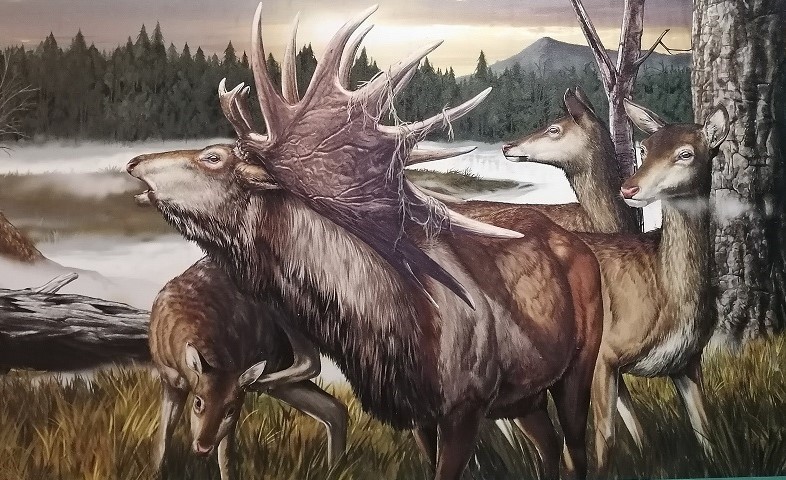
Irish Elk Megaloceros giganteus (Blumenbach, 1803)
Also known as the giant elk of the peat bogs or Irish Elk, this herbivore could stand 180 cm tall at the shoulder and its huge antlers were sometimes over 300 cm wide. Coming from China, it appeared in Europe during the Middle Pleistocene, sharing the wetlands and taiga with bison, mammoths and horses. Its extinction in the Po Valley seems to have occurred at the end of the last Ice Age, coinciding with the spread of closed forest at the expense of the vast grasslands. Prehistoric man actively hunted it, perhaps driving it into the tangled vegetation where its huge antlers hampered its movements.
The fossil remains of the predators at the top of the food chain, such as wolves, lions, foxes, hyenas and some species of bears are much rarer than those of their prey. This reflects what happens in nature, where carnivores are much less numerous than herbivores and their remains are therefore much less likely to fossilize.

Appearing in the early Miocene, the bovids underwent an explosive adaptive radiation in the Late Miocene. In the Pleistocene forms very similar to today’s bison and cattle were found in Europe.
Steppe Bison Bison priscus (Bojanus, 1827)
This is one of the commonest species in fossil deposits in the Po Valley. It appeared in Europe during the Middle Pleistocene, coming from the East. It occupied the cold, arid steppes during the last Wurmian glacial phase, together with the woolly mammoth. Its height at the shoulders approached 200 cm and the arcs of the great horns with swept back tips could be up to 120 cm wide. This species gave rise to the current European form, Bison bonasus, which still survives in the wild in protected areas of Poland and Belarus.
Aurochs (primeval cattle) Bos primigenius (Bojanus, 1827)
This was the wild form of today’s domestic cattle. Compared to the latter the aurochs had a more massive structure, even heftier than the bison’s. Its sexual dimorphism was strongly marked, large females being only two-thirds the size of males. Appearing in the early Middle Pleistocene, it reached its greatest size (220 cm at the shoulder) in the Holocene. It was most widespread when the forested areas opened out into large glades, while it retreated into more sheltered areas with a Mediterranean climate during the coldest intervals. This large herbivore finally died out in the seventeenth century because of hunting by humans and competition with domesticated forms: the last recorded specimen died in Lithuania in 1628.

Red deer Cervus elaphus (Linnaeus, 1758)
The current form of deer has been present in Europe since the second half of the Middle Pleistocene. In Italy it has survived since then in some areas of the Alps, while it has been reintroduced to the Apennines. It lives mainly near clearings in forests of conifers and deciduous trees. It stands up to 150 cm high at the shoulder.
Elk Alces alces (Linnaeus, 1758)
This is the same species still found in Northern Europe. It has been conjectured that it became differentiated from the extinct form Alces latifrons in the Middle Pleistocene. It lives near swamps or watercourses in open birch or pine forests. In Italy fossils have been reported in the Po Valley and Liguria, while it seems that never to have spread to the south.
Broad-Fronted Moose Alces latifrons (Johnson, 1874)
This differed from the present species by its much longer beams (the main stems of the antlers). In Europe fossils are very common, but rare in Italy, where they have been reported only at Ranica (BG) and near Voghera, along the Pavian stretch of the Po. They appeared in the Pleistocene and became extinct after the last interglacial phase. They lived in more open environments than those favoured by Alces alces.
The origin of the family Ursidae, which appeared relatively recently, dates from at the beginning of the Miocene. Beginning with archaic forms about the size of a fox, the general trend has been an increase in size and adaptation of the teeth to an omnivorous or even herbivorous diet. The genus Ursus appeared in the Pliocene, with the species U. minimus.
Deninger’s Bear Ursus deningeri (von Reichenau, 1904)
Characteristic of the post-Villafranchian faunas of the Early and Middle Pleistocene, this creature was about the same size as the modern brown bear. Its remains are frequent in Palaeolithic deposits and show that it was hunted by human populations.
Cave Bear Ursus spelaeus (Rosenmuller and Heinroth, 1794)
This is the largest ursid to be found in Europe and the commonest in the fossil record (the Dragon Cave in Austria alone yielded 30,000 specimens). It was very common in northern and central Italy until the woodlands shrank and turned to steppe. It probably originated from U. deningeri, which became extinct between the Pleistocene and Holocene. It was mainly herbivorous and the males were much larger than the females.
Brown Bear Ursus arctos (Linnaeus, 1758)
The brown bear, an omnivore, originated in China in the Middle Pleistocene, but later spread to Europe, where it co-existed with the cave bears but unlike them did not become extinct. Today it is among the species in danger of extinction due to the drastic depletion of its environment, caused by humans, who have decimated the surviving specimens.
Hippopotamus amphibius (Linnaeus, 1758)
Clearly differentiated in Africa as early as the Pliocene, during the Pleistocene the hippopotami made many migrations as a function of climate change, travelling as far as England during the interglacial intervals with warm climates. Fossil remains are found in the Po Valley from the Middle Pleistocene to the early stages of the last glacial interval (Wurm). Most scholars hold this was the same species that currently lives in Africa, up to 165 cm high at the shoulder. A herbivore, the hippo spends most of its time in pools of water.
Sus scrofa (Linnaeus, 1758)
The wild boar, an omnivore, spread all through the Middle Pleistocene and is still present in many regions of Asia and Europe, including Italy. Fossil forms were slightly larger than those found today, but like these, they lived in small herds in the rich underbrush of forest environments in areas with a temperate climate.
Alluvial deposits in the Po Valley have been found to contain bones belonging to at least four different species of proboscideans, three to the genus Mammuthus and one to Elephas. The three species of mammoth discovered derive one from another and they all originated in Asia, from the lower Pleistocene, arriving later in Europe. In Italy, Mammuthus meridionalis has been reported from 2 million to 700,000 years ago, Mammuthus trogontherii from 700,000 to 200,000 years ago, and Mammuthus primigenius from 200,000 to about 20,000 years ago. Elephas antiquus also arrived in Europe from Asia, and remained here until 40,000 years ago. It is important to remember that the proboscideans originated in Africa, from where they subsequently migrated to Asia and other continents.
Ancient Elephant
Elephas antiquus (Falconer & Coutley, 1847)
Up to 4 m tall at the shoulder, this large herbivore had long tusks that were only slightly arched and closely resembled today’s African elephant in appearance. It appeared in Western Europe in the Early Pleistocene and its remains are more common in deposits relating to periods when the climate was temperate. In central Italy this species was present when the horse and aurochs became the dominant forms. It also spread to the north during interglacials.
Southern Mammoth
Elephas meridionalis (Nesti, 1825)
This mammoth appeared in the Pleistocene and was associated with cold to temperate climates. The earliest forms were smaller forest-dwellers, but they soon gave rise to giants 4 m high at the shoulder living in more open environments. In appearance it was much like the Indian elephant, with curved, divergent tusks.
Woolly Mammoth
Mammuthus primigenius (Blumenbach, 1799)
This is one of the best-known extinct creatures, because of the notable finds of complete frozen specimens, mainly in Siberia. The remains found in the Po Valley consist rather of individual disarticulated bones, due largely to the action of the currents of the Po and its tributaries, which have scattered the various skeletal parts along their course.
The males of this species could stand higher than 3 m at the shoulder; the females were smaller. Both sexes, however, had long curved tusks, perhaps used for scraping away snow and digging up plants. The woolly mammoth was closely tied to cold, arid steppe environments and disappeared after the last glacial period, in part because of hunting by humans. The meat of these pachyderms was one of the principal food sources for humans of the Palaeolithic in central and northern Europe. The non-edible parts of its body were also used for making tools, garments, decorative items and building materials.
Castell'Arquato’s hills are modeled on the sediments deposited in a period of time ranging from 5 to about 1.2 million years ago in an arm of the sea that occupied the current Po Valley. This sea was the natural habitat of a great quantity of organisms: molluscs, crabs, corals and cetaceans.
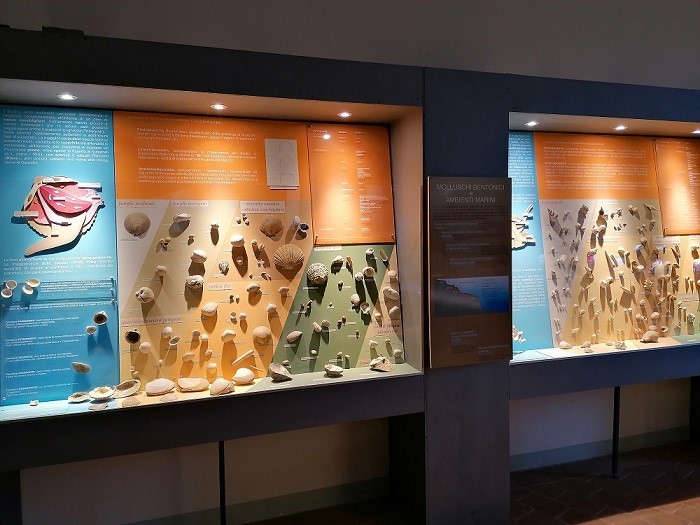
Their remains, imprisoned for millennia in the sands and clays, today appear in the form of fossils. Most of the eastern part of Piacenza’s area is so rich of fossils that a Pliocene geological plan is universally known as "Piacenziano".
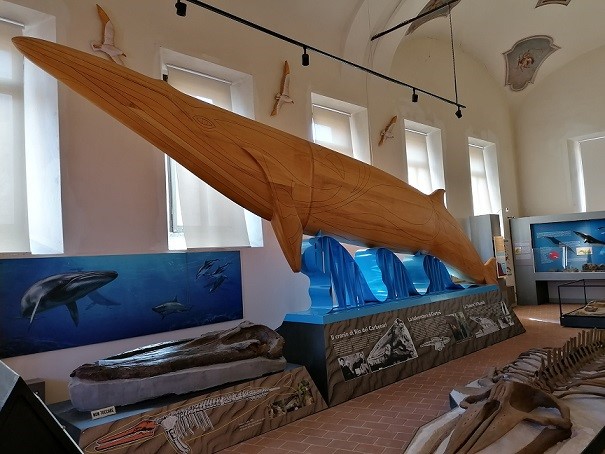
The process that led to the formation of the Apennines began about 35 million years ago, when Corsica and Sardinia split off from the southern part of what is now France and began to rotate anticlockwise. With the emergence of the mountain range of the Apennines, the central and northern Mediterranean found itself divided in two: a palaeo-Tyrrhenian part in the west and a palaeo-Adriatic part in the east. The palaeo-Adriatic region was continued into a vast gulf that stretched into what is now the Po Valley and came to include almost the whole of Piedmont. Between about 10 and 3 million years ago (hence between the Miocene and Pliocene), this great gulf was occupied by fairly shallow seas that enjoyed a warm climate. These waters contained dolphins, whales, sirenids and fish, many of which were tropical or subtropical in affinity, together with hundreds of species of molluscs, crabs and other invertebrates.
The cetaceans of this gulf included the whales (shown by a skeleton preserved in Reggio Emilia and various fragments preserved in Modena), fin whales (the skull from Rio Carbonari is one example, but others are preserved in Parma, Bologna, Salsomaggiore Terme, Vignola and Asti), grey whales (a skeleton is preserved in Turin) and various species of dolphins (Castell’Arquato, Salsomaggiore Terme, Torino).
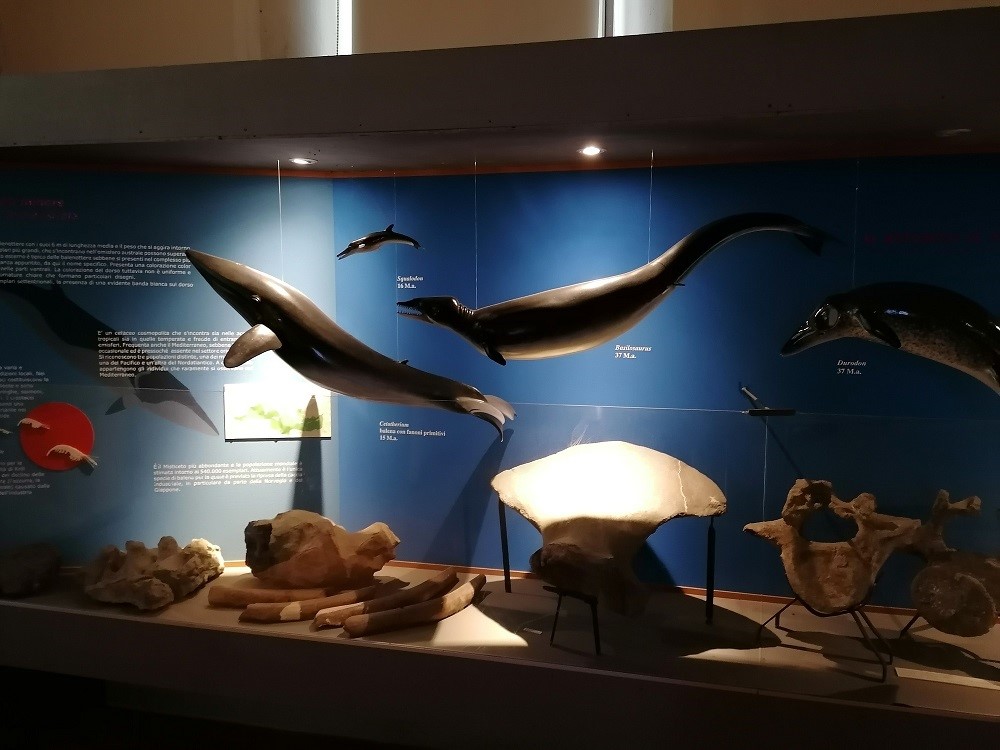
The problem of the origin of the cetaceans still stirs heated debate among scientists. Although the study of the DNA of the species currently living and the discovery of new fossils have provided new clues, scientists are still not agreed on what mammal species still living is closest to the whales and dolphins. The fossils suggest that the origin of cetaceans should be sought in an extinct group of cloven-hoofed animals (mammals that today include pigs, ruminants, antelopes etc.) termed mesonychids. These were the only carnivorous artiodactyls that ever appeared on earth and the cetaceans, as we know, are likewise carnivores. The mesonychids had a very large head and delicate legs like those of a deer. The study of their DNA suggests instead that cetaceans are closely related to today’s hippos and are derived from the ancestors of these large mammals with amphibious habits. Recently some Palaeontologists have presented anatomical evidence in favour of this last conjecture. In particular, the form of the legs joints (the ankle, above all) of the oldest cetaceans and of hippos are said to have many features in common. But there still remain many questions that new fossils and more sophisticated analyses should be able to answer.
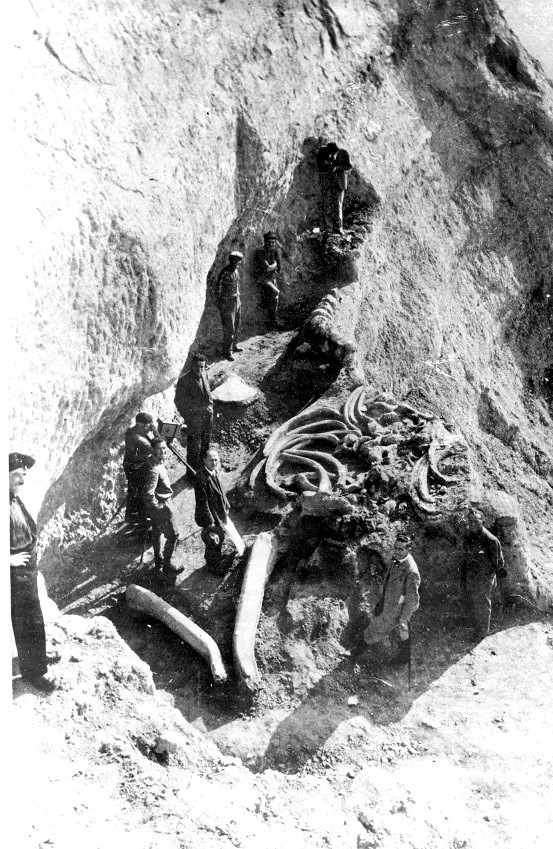
The fossil record of the “Pliocene Sea” has been brought to light since the late eighteenth century along the steep cliffs and gullies and the small watercourses cut into the rocks between the Torrente Nure and Torrente Arda.
Among the first scholars to make a decisive contribution to exploring and understanding Pliocene Piacenza was Giuseppe Cortesi, a counsellor at the court of law in Piacenza, and later honorary professor of Geology at the University of Parma. His fascination with the relics of the past in this area led him to collect important finds of shells, rhinoceroses, elephants, dolphins and whales. In addition to the first documented discovery of the remains of a whale, which occurred in 1793, Cortesi also had the merit of describing his finds in detail in his “Geological Essays on the States of Parma and Piacenza”, published in 1819. On Cortesi’s death there was a sharp decline in research, except for the activity of Giovanni Podestà, who collected fossils and in 1842 discovered the remains of a dolphin and a whale. In 1886 the discoveries were resumed with finds of several vertebrae in the Burrone del Gallo, under Monte Pulgnasco at Montezago. In late 1895 the remains of a delphinoid were found in Rio Stramonte by the Pallastrelli brothers of Castell’Arquato. Two years later, in the vicinity of Bacedasco the remains of a Burtinopsis similis were brought to light, and in January 1899, again in Rio Stramonte, various skeletal parts belonging to a whale were recovered. These were the last discoveries of the nineteenth century and attracted the interest of the leading palaeontologists of the period. They included Cuvier, Brandt, Van Beneden and the Italians Strobel, Capellini, Del Prato and Simonelli.
The early decades of the twentieth century were not particularly rich in finds of the remains of cetaceans and other fossil vertebrates. There were only sporadic finds of vertebrae and ribs until 1934. In that year Dr. Antonino Menozzi discovered the remains of a large whale in the calanchi (eroded hillsides) of Monte Falcone, near the medieval village. The complex work of recovery lasted almost two years and brought to the light, in addition to the spine, a large number of ribs and the left shoulder blade and jaw.
To record the exceptional discovery the Istituto Luce made a short documentary that was screened in cinemas around the country. After this no significant remains of cetaceans were found until April 1983, when the fossil skull of Balaenoptera acutorostrata came to light almost complete and very well preserved, in the calanchi overlooking Rio dei Carbonari. The discovery was made by Roberto and Piero Volpi and Luigi Rusconi during one of their periodic searches for fossils in the calanchi near the village of Tabiano di Lugagnano. In 1986, skeletal parts of fin whales were found in the calanchi of Bacedasco and near Chiavenna Rocchetta. Also in Val Chiavenna, along the eroded incisions of the Rio Stramonte, a dolphin skull came to light in 1991. The last major discovery dates from 2009: the skeleton of a dolphin, found in the village of Torrazza di Montezago by Paolo Umili and Paolo Evangelista.
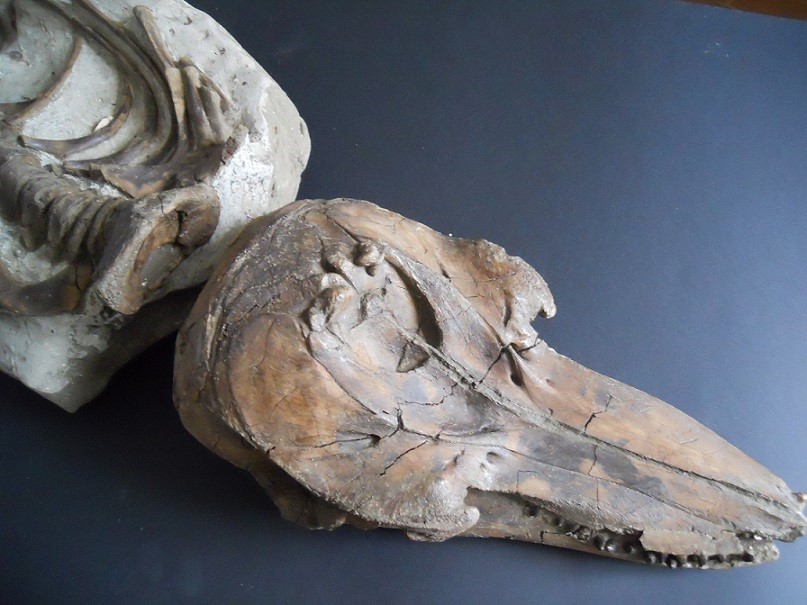
This specimen was found by Paolo Umili and Paolo Evangelista of the “La Xenophora” Group on 5 October 2009 in the Pliocene clay of the Val Chiavenna (Lugagnano).
It consists of a skull in a splendid state of preservation, with the rami of the mandibles, teeth and auditory bones still in articulation, a block with 7 cervical vertebrae, 6 thoracic vertebrae, 6 ribs on the left side, 9-11 fragmented ribs on the right side, a bony fragment tentatively identified with the hyoid bone, and a block containing 7 lumbar vertebrae. The find is still being studied.
The skeleton rests on its back and shows signs of the collapse after death of the left side of the rib cage onto the right side, which rested on the silt-clay substrate.
From an anatomical point of view, the wonderful state of preservation of this skeleton allows very close comparisons with the living and fossil species of toothed whales. First of all, it can be observed that the teeth suggest a particularly strong affinity with the bottlenose dolphin (or tursiope) and the zygomatic arch has features in common with delphinids such as Sousa or Steno. Other details of the cranial anatomy suggest a particular similarity with the genus Steno, a dolphin currently widespread in tropical seas. However, since the find is still being studied, it is possible that closer examination will reveal characteristics that make it possible to assign it more precisely to a known genus of cetaceans.
To do this, the study of the skeleton will make use of the additional information derived from an X-ray examination using computed tomography (CT). This examination was performed through the good offices of Giancarlo Artoni of the Department of Radiological Functions of the AUSL of Piacenza UO Radiologia Valdarda at the Hospital of Fiorenzuola d'Arda directed by Dr. Egidio Carella. The CT will make possible the virtual reconstruction of the auditory bones still encapsulated within the matrix and the reconstruction and study of the brain surface. These data will be of great value in the study of the specimen’s phylogenetic relations and so permit, for the first time in Europe, the reconstruction of the surface of the brain of a cetacean of a species extinct for over 3 million years.
The conservative restoration is funded by the Istituto Beni Artistici, Culturali e Naturali of the Regione Emilia Romagna.